| Listing 1 - 10 of 64 | << page >> |
Sort by
|
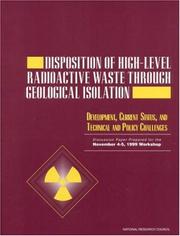
ISBN: 0309067782 9786610185665 128018566X 0309593824 0585198055 9780585198057 9780309067782 0309184584 Year: 1999 Publisher: Washington, D.C. : National Academy Press,
Abstract | Keywords | Export | Availability | Bookmark
 Loading...
Loading...Choose an application
- Reference Manager
- EndNote
- RefWorks (Direct export to RefWorks)
TECHNOLOGY & ENGINEERING --- Power Resources / Nuclear --- Radioactive waste disposal in the ground. --- Burial of radioactive wastes --- Ground radioactive waste disposal --- Underground radioactive waste disposal --- Hazardous waste sites --- Waste disposal in the ground --- Radioactive waste repositories
Book
ISBN: 008100642X 0081006527 1306198372 9780081006528 9780081006429 Year: 2017 Publisher: Duxford, United Kingdom Woodhead Publishing
Abstract | Keywords | Export | Availability | Bookmark
 Loading...
Loading...Choose an application
- Reference Manager
- EndNote
- RefWorks (Direct export to RefWorks)
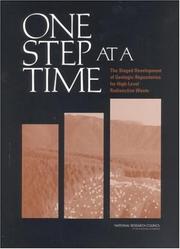
ISBN: 0309087082 0309505488 9780309505482 9780309087087 0305087082 0309168511 Year: 2003 Publisher: Washington, D.C. National Academies Press
Abstract | Keywords | Export | Availability | Bookmark
 Loading...
Loading...Choose an application
- Reference Manager
- EndNote
- RefWorks (Direct export to RefWorks)
Environmental protection. Environmental technology --- Nuclear energy --- Radioactive waste disposal in the ground. --- Radioactive waste disposal in the ground --- Burial of radioactive wastes --- Ground radioactive waste disposal --- Underground radioactive waste disposal --- Hazardous waste sites --- Waste disposal in the ground --- Radioactive waste repositories
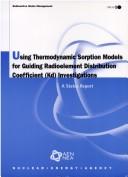
ISBN: 1280034416 9786610034413 926419293X 9789264192935 9264186794 Year: 2001 Publisher: Paris : OECD Publishing,
Abstract | Keywords | Export | Availability | Bookmark
 Loading...
Loading...Choose an application
- Reference Manager
- EndNote
- RefWorks (Direct export to RefWorks)
A general consensus has been reached among technical experts that high-level radioactive waste can safely be disposed of in deep geological repositories. Safety studies are carried out to evaluate the overall capacity of a particular disposal site to confine waste and minimise radioactive releases. Since the principal way in which radioactive elements might eventually reach the biosphere is by transport of dissolved radionuclides in groundwater, the safety study calculations must be able to estimate their rate of transfer through each of the barriers surrounding the repository. It is well known that, for many radioelements, sorption reactions can lead to a reduction of the amount of radionuclides present in the solution phase. How best to take radionuclide sorption reactions into account in repository performance assessment models is the subject of this book.
Radioactive waste disposal in the ground. --- Radioactive waste management. --- Radioactive waste. --- Radioactive waste disposal in the ground --- Environmental Engineering --- Civil & Environmental Engineering --- Engineering & Applied Sciences --- Burial of radioactive wastes --- Ground radioactive waste disposal --- Underground radioactive waste disposal --- Hazardous waste sites --- Waste disposal in the ground --- Radioactive waste repositories --- Radioactive Waste --- Déchets radioactifs --- Elimination dans le sol
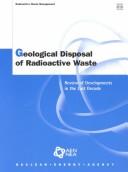
ISBN: 9246180542 128003419X 9786610034192 9246180540 9264171940 Year: 1999 Publisher: Paris : OECD Publishing,
Abstract | Keywords | Export | Availability | Bookmark
 Loading...
Loading...Choose an application
- Reference Manager
- EndNote
- RefWorks (Direct export to RefWorks)
The concept of removing long-lived radioactive wastes from the human environment by disposal in deep geological repositories was developed several decades ago. In the intervening years, research efforts world-wide have increased our knowledge and understanding of how underground disposal systems will function over very long periods of time. Significant progress has also been made towards implementation of such facilities. There have, however, been delays in the disposal programmes of several countries. This report is a review of developments in the past decade. The primary sources of information are the answers to a questionnaire provided by waste management organisations represented in the NEA Radioactive Waste Management Committee (RWMC). The latter is an international forum of senior specialists from safety authorities, waste management agencies, R&D institutions and policy-making bodies.
Geological repositories. --- Radioactive waste disposal in the ground. --- Seepage. --- Radioactive waste disposal in the ground --- Environmental Engineering --- Civil & Environmental Engineering --- Engineering & Applied Sciences --- Burial of radioactive wastes --- Ground radioactive waste disposal --- Underground radioactive waste disposal --- Hazardous waste sites --- Waste disposal in the ground --- Radioactive waste repositories --- Déchets radioactifs --- Elimination dans le sol --- Radioactive Waste Storing
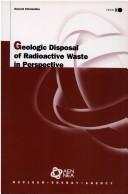
ISBN: 1280034262 9786610034260 9264187634 9264184252 Year: 2000 Publisher: Paris : OECD Publishing,
Abstract | Keywords | Export | Availability | Bookmark
 Loading...
Loading...Choose an application
- Reference Manager
- EndNote
- RefWorks (Direct export to RefWorks)
One of the challenges facing the continued availability of nuclear energy is that of ensuring the safe, environmentally acceptable and economic management of the waste generated during its production. There is a broad scientific and technical consensus that disposal of high-level, long-lived radioactive waste in deep geologic formations is an appropriate and safe means of isolating it from the biosphere for very long time scales. There have, however, been setbacks in the disposal programmes in many countries, primarily due to the failure of the waste management community to win sufficient public and political support. This report, which is based on recent work of the OECD Nuclear Energy Agency (NEA), reviews the progress to date in this field and the further steps that may be required to implement geologic disposal, taking into account both the technical and regulatory requirements, and the need to achieve an appropriate level of societal acceptance.This book should be of interest to government and industry decision makers, academics and all those eager to better understand what is at stake in this widely debated subject and the prospects that emerge.
Radioactive waste disposal in the ground. --- Radioactive wastes -- Management. --- Radioactive wastes. --- Radioactive waste disposal in the ground --- Civil & Environmental Engineering --- Engineering & Applied Sciences --- Environmental Engineering --- Burial of radioactive wastes --- Ground radioactive waste disposal --- Underground radioactive waste disposal --- Hazardous waste sites --- Waste disposal in the ground --- Radioactive waste repositories --- Déchets radioactifs --- Elimination dans le sol
Book
ISBN: 9781411329454 Year: 2010 Publisher: Reston U.S. Geological Survey
Abstract | Keywords | Export | Availability | Bookmark
 Loading...
Loading...Choose an application
- Reference Manager
- EndNote
- RefWorks (Direct export to RefWorks)
Geological repositories. --- Radioactive waste disposal in the ground --- Seepage. --- Soil chemistry. --- Geological repositories --- Seepage --- Soil chemistry --- Agricultural chemistry --- Geochemistry --- Infiltration --- Water --- Hydraulics --- Soil infiltration rate --- Soil percolation --- Burial of radioactive wastes --- Ground radioactive waste disposal --- Underground radioactive waste disposal --- Hazardous waste sites --- Waste disposal in the ground --- Radioactive waste repositories --- Deep geologic repositories --- Deep geologic disposal
Book
ISBN: 9264177825 9264177817 Year: 2012 Publisher: Paris : Nuclear Energy Agency, Organization for Economic Cooperation and Development,
Abstract | Keywords | Export | Availability | Bookmark
 Loading...
Loading...Choose an application
- Reference Manager
- EndNote
- RefWorks (Direct export to RefWorks)
A central safety function of radioactive waste disposal repositories is the prevention or sufficient retardation of radionuclide migration to the biosphere. Performance assessment exercises in various countries, and for a range of disposal scenarios, have demonstrated that one of the most important processes providing this safety function is the sorption of radionuclides along potential migration paths beyond the engineered barriers. Thermodynamic sorption models (TSMs) are key for improving confidence in assumptions made about such radionuclide sorption when preparing a repository's safety case. This report presents guidelines for TSM development as well as their application in repository performance assessments. They will be of particular interest to the sorption modelling community and radionuclide migration modellers in developing safety cases for radioactive waste disposal.
Radioactive waste disposal in the ground -- Safety measures. --- Radioactive waste disposal in the ground. --- Radioisotopes -- Safety measures. --- Radioactive waste disposal in the ground --- Radioisotopes --- Safety measures. --- Burial of radioactive wastes --- Ground radioactive waste disposal --- Underground radioactive waste disposal --- Hazardous waste sites --- Waste disposal in the ground --- Radioactive waste repositories
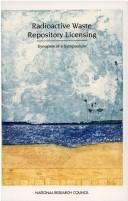
ISBN: 0309046912 9786610203031 128020303X 0309597935 0585099766 9780585099767 9780309046916 Year: 1992 Publisher: Washington, D.C. National Academy Press
Abstract | Keywords | Export | Availability | Bookmark
 Loading...
Loading...Choose an application
- Reference Manager
- EndNote
- RefWorks (Direct export to RefWorks)
Radioactive waste sites --- Radioactive waste disposal --- Radioactive waste disposal in the ground --- Radioactive waste disposal in the ground. --- Licenses --- Law and legislation --- Licenses. --- Law and legislation. --- Burial of radioactive wastes --- Ground radioactive waste disposal --- Underground radioactive waste disposal --- Dumping sites, Radioactive --- Radioactive dumping sites --- Radioactive waste disposal sites --- Radioactive waste facilities --- Hazardous waste sites --- Waste disposal in the ground --- Radioactive waste repositories
Book
ISBN: 9789264274150 Year: 2017 Publisher: Paris : OECD Publishing,
Abstract | Keywords | Export | Availability | Bookmark
 Loading...
Loading...Choose an application
- Reference Manager
- EndNote
- RefWorks (Direct export to RefWorks)
Radioactive waste repositories. --- Radioactive waste disposal in the ground. --- Burial of radioactive wastes --- Ground radioactive waste disposal --- Underground radioactive waste disposal --- Hazardous waste sites --- Waste disposal in the ground --- Radioactive waste repositories --- Nuclear waste repositories --- Geological repositories --- Radioactive waste sites --- Radioactive waste disposal in the ground
| Listing 1 - 10 of 64 | << page >> |
Sort by
|

 Search
Search Feedback
Feedback About UniCat
About UniCat  Help
Help News
News